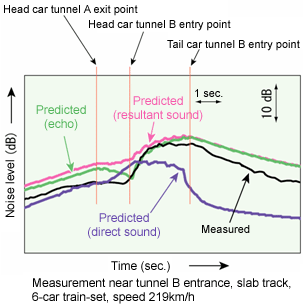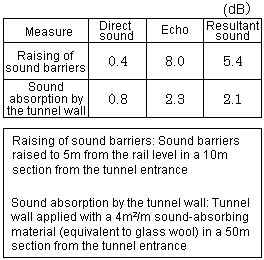|
The noise level near tunnel entrances is higher than that in open sections, since the noise reflected in the tunnel and emitted from the tunnel entrance (via echo) is superimposed onto the normal running noise. To predict the noise level near Shinkansen tunnel entrances, the RTRI proposed a method combining the tunnel entrance noise prediction technique used in the field of road traffic noise with the noise source model used by the RTRI's Shinkansen noise prediction technique.
This method predicts the noise near a tunnel entrance by separating the echo from the noise that directly reaches the measuring point (i.e. the direct sound). A comparison between the measured and predicted sound levels indicated qualitatively similar trends (Fig. 1). When a compensation term was considered to represent the effect of the tunnel entrance being shielded by the car body, the values also agreed quantitatively.
The RTRI also proposed measures to raise sound barriers and apply a sound-absorbing material on the tunnel wall, and predicted the effects of these measures. The results clarified the effectiveness of raising the sound barriers near the tunnel entrance to completely shield the entrance when viewed from the observation point, and showed that this was more effective than sound absorption by the tunnel wall (Table 1).

Fig. 1 Comparison of the changes in sound levels over time | Table 1 Effect of noise reduction at tunnel entrance
(slab track, height of rail level from the ground 4.7m, 3.5m-high upright sound barrier from the rail level, speed 300km/h)
 |
HOME > Major Results of Research and Development in Fiscal 2004 > IV Harmonization with the environment

RTRI HOME
Copyright(c) 2005 Railway Technical Research Institute,Tokyo Japan, All rights reserved.
|

